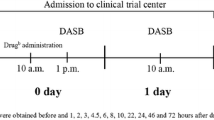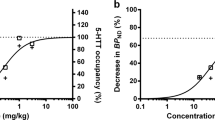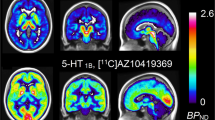Abstract
Rationale
A number of serotonin receptor positron emission tomography (PET) radioligands have been shown to be sensitive to changes in extracellular serotonin concentration, in a generalization of the well-known dopamine competition model. High doses of selective serotonin reuptake inhibitors (SSRIs) decrease serotonin receptor availability in monkey brain, consistent with increased serotonin concentrations. However, two recent studies on healthy human subjects, using a single, lower and clinically relevant SSRI dose, showed increased cortical serotonin receptor radioligand binding, suggesting potential decreases in serotonin concentration in projection regions when initiating treatment.
Objectives
The cross-species differential SSRI effect may be partly explained by serotonin transporter (SERT) occupancy in monkey brain being higher than is clinically relevant. We here determine SERT occupancy after single doses of escitalopram or citalopram by conducting PET measurements with [11C]MADAM in monkeys. Relationships between dose, plasma concentration and SERT occupancy were estimated by one-site binding analyses. Binding affinity was expressed as dose (ID50) or plasma concentration (K i) where 50 % SERT occupancy was achieved.
Results
Estimated ID50 and K i values were 0.020 mg/kg and 9.6 nmol/L for escitalopram and 0.059 mg/kg and 9.7 nmol/L for citalopram, respectively. Obtained K i values are comparable to values reported in humans.
Conclusions
Escitalopram or citalopram doses nearly saturated SERT in previous monkey studies which examined serotonin sensitivity of receptor radioligands. PET-measured cross-species differential effects of SSRI on cortical serotonin concentration may thus be related to SSRI dose. Future monkey studies using SSRI doses inducing clinically relevant SERT occupancy may further illuminate the delayed onset of SSRI therapeutic effects.




Similar content being viewed by others
References
Adell A, Artigas F (1991) Differential effects of clomipramine given locally or systemically on extracellular 5-hydroxytryptamine in raphe nuclei and frontal cortex. An in vivo brain microdialysis study. Naunyn Schmiedeberg’s Arch Pharmacol 343:237–244
Andree B, Nyberg S, Ito H, Ginovart N, Brunner F, Jaquet F, Halldin C, Farde L (1998) Positron emission tomographic analysis of dose-dependent MDL 100,907 binding to 5-hydroxytryptamine-2A receptors in the human brain. J Clin Psychopharmacol 18:317–323
Artigas F (1993) 5-HT and antidepressants: new views from microdialysis studies. Trends Pharmacol Sci 14:262
Baldinger P, Kranz GS, Haeusler D, Savli M, Spies M, Philippe C, Hahn A, Hoflich A, Wadsak W, Mitterhauser M, Lanzenberger R, Kasper S (2014) Regional differences in SERT occupancy after acute and prolonged SSRI intake investigated by brain PET. Neuroimage 88:252–262
Batis J, Barret O, Alagille D, Koren AO, Stehouwer JS, Cosgrove K, Goodman M, Seibyl J, Tamagnan G (2012) In vivo evaluation of [123I]mZIENT as a SPECT radioligand for the serotonin transporter. Nucl Med Biol 39:1137–1141
Bel N, Artigas F (1992) Fluvoxamine preferentially increases extracellular 5-hydroxytryptamine in the raphe nuclei: an in vivo microdialysis study. Eur J Pharmacol 229:101–103
Catafau AM, Perez V, Plaza P, Pascual JC, Bullich S, Suarez M, Penengo MM, Corripio I, Puigdemont D, Danus M, Perich J, Alvarez E (2006) Serotonin transporter occupancy induced by paroxetine in patients with major depression disorder: a 123I-ADAM SPECT study. Psychopharmacology (Berlin) 189:145–153
Chalon S, Tarkiainen J, Garreau L, Hall H, Emond P, Vercouillie J, Farde L, Dasse P, Varnas K, Besnard JC, Halldin C, Guilloteau D (2003) Pharmacological characterization of N,N-dimethyl-2-(2-amino-4-methylphenyl thio)benzylamine as a ligand of the serotonin transporter with high affinity and selectivity. J Pharmacol Exp Ther 304:81–87
Cosgrove KP, Staley JK, Baldwin RM, Bois F, Plisson C, Al-Tikriti MS, Seibyl JP, Goodman MM, Tamagnan GD (2010) SPECT imaging with the serotonin transporter radiotracer [123I]p ZIENT in nonhuman primate brain. Nucl Med Biol 37:587–591
Cosgrove KP, Kloczynski T, Nabulsi N, Weinzimmer D, Lin SF, Staley JK, Bhagwagar Z, Carson RE (2011) Assessing the sensitivity of [11C]p943, a novel 5-HT1B radioligand, to endogenous serotonin release. Synapse 65:1113–1117
Elfving B, Bjornholm B, Knudsen GM (2003) Interference of anaesthetics with radioligand binding in neuroreceptor studies. Eur J Nucl Med Mol Imaging 30:912–915
Elfving B, Madsen J, Knudsen GM (2007) Neuroimaging of the serotonin reuptake site requires high-affinity ligands. Synapse 61:882–888
Erichsen MN, Huynh TH, Abrahamsen B, Bastlund JF, Bundgaard C, Monrad O, Bekker-Jensen A, Nielsen CW, Frydenvang K, Jensen AA, Bunch L (2010) Structure-activity relationship study of first selective inhibitor of excitatory amino acid transporter subtype 1: 2-amino-4-(4-methoxyphenyl)-7-(naphthalen-1-yl)-5-oxo-5,6,7,8-tetrahydro-4H-chrom ene-3-carbonitrile (UCPH-101). J Med Chem 53:7180–7191
Farde L, Wiesel FA, Halldin C, Sedvall G (1988) Central D2-dopamine receptor occupancy in schizophrenic patients treated with antipsychotic drugs. Arch Gen Psychiatry 45:71–76
Farde L, Wiesel FA, Nordstrom AL, Sedvall G (1989) D1- and D2-dopamine receptor occupancy during treatment with conventional and atypical neuroleptics. Psychopharmacology (Berlin) 99:S28–31
Finnema SJ, Varrone A, Hwang TJ, Gulyas B, Pierson ME, Halldin C, Farde L (2010) Fenfluramine-induced serotonin release decreases [11C]AZ10419369 binding to 5-HT1B-receptors in the primate brain. Synapse 64:573–577
Finnema SJ, Varrone A, Hwang TJ, Halldin C, Farde L (2012) Confirmation of fenfluramine effect on 5-HT1B receptor binding of [11C]AZ10419369 using an equilibrium approach. J Cereb Blood Flow Metab 32:685–695
Garber JC, Barbee RW, Bielitzki JT, Clayton LA, Donovan JC, Hendriksen CFM, Kohn DF, Lipman NS, Locker PA, Melcher J, Quimby FW, Turner PV, Wood GA, Wurbel H (2011) Guide for the care and use of laboratory animals. The National Academies Press, Washington DC
Halldin C, Lundberg J, Sovago J, Gulyas B, Guilloteau D, Vercouillie J, Emond P, Chalon S, Tarkiainen J, Hiltunen J, Farde L (2005) [11C]MADAM, a new serotonin transporter radioligand characterized in the monkey brain by PET. Synapse 58:173–183
Herold N, Uebelhack K, Franke L, Amthauer H, Luedemann L, Bruhn H, Felix R, Uebelhack R, Plotkin M (2006) Imaging of serotonin transporters and its blockade by citalopram in patients with major depression using a novel SPECT ligand [123I]-ADAM. J Neural Transm 113:659–670
Hinz R, Selvaraj S, Murthy NV, Bhagwagar Z, Taylor M, Cowen PJ, Grasby PM (2008) Effects of citalopram infusion on the serotonin transporter binding of [11C]DASB in healthy controls. J Cereb Blood Flow Metab 28:1478–1490
Invernizzi R, Belli S, Samanin R (1992) Citalopram’s ability to increase the extracellular concentrations of serotonin in the dorsal raphe prevents the drug’s effect in the frontal cortex. Brain Res 584:322–324
Jorgensen TN, Christensen PM, Gether U (2014) Serotonin-induced down-regulation of cell surface serotonin transporter. Neurochem Int 73:107–112
Karlsson P, Farde L, Halldin C, Swahn CG, Sedvall G, Foged C, Hansen KT, Skrumsager B (1993) PET examination of [11C]NNC 687 and [11C]NNC 756 as new radioligands for the D1-dopamine receptor. Psychopharmacology (Berlin) 113:149–156
Kent JM, Coplan JD, Lombardo I, Hwang DR, Huang Y, Mawlawi O, Van Heertum RL, Slifstein M, Abi-Dargham A, Gorman JM, Laruelle M (2002) Occupancy of brain serotonin transporters during treatment with paroxetine in patients with social phobia: a positron emission tomography study with 11C McN 5652. Psychopharmacology (Berlin) 164:341–348
Lammertsma AA, Hume SP (1996) Simplified reference tissue model for PET receptor studies. Neuroimage 4:153–158
Lanzenberger R, Kranz GS, Haeusler D, Akimova E, Savli M, Hahn A, Mitterhauser M, Spindelegger C, Philippe C, Fink M, Wadsak W, Karanikas G, Kasper S (2012) Prediction of SSRI treatment response in major depression based on serotonin transporter interplay between median raphe nucleus and projection areas. Neuroimage 63:874–881
Lundberg J, Christophersen JS, Petersen KB, Loft H, Halldin C, Farde L (2007) PET measurement of serotonin transporter occupancy: a comparison of escitalopram and citalopram. Int J Neuropsychopharmacol 10:777–785
Lundberg J, Tiger M, Landen M, Halldin C, Farde L (2012) Serotonin transporter occupancy with TCAs and SSRIs: a PET study in patients with major depressive disorder. Int J Neuropsychopharmacol 15:1167–1172
Meyer JH, Wilson AA, Sagrati S, Hussey D, Carella A, Potter WZ, Ginovart N, Spencer EP, Cheok A, Houle S (2004) Serotonin transporter occupancy of five selective serotonin reuptake inhibitors at different doses: an [11C]DASB positron emission tomography study. Am J Psychiatry 161:826–835
Milak MS, Severance AJ, Prabhakaran J, Kumar JS, Majo VJ, Ogden RT, Mann JJ, Parsey RV (2011) In vivo serotonin-sensitive binding of [11C]CUMI-101: a serotonin 1A receptor agonist positron emission tomography radiotracer. J Cereb Blood Flow Metab 31:243–249
Mukaida K, Shichino T, Koyanagi S, Himukashi S, Fukuda K (2007) Activity of the serotonergic system during isoflurane anesthesia. Anesth Analg 104:836–839
Nord M, Finnema SJ, Halldin C, Farde L (2013) Effect of a single dose of escitalopram on serotonin concentration in the non-human and human primate brain. Int J Neuropsychopharmacol 16:1577–1586
Nyberg S, Dencker SJ, Malm U, Dahl ML, Svenson JO, Halldin C, Naskashima Y, Farde L (1998) D2- and 5-HT2 receptor occupancy in high-dose neuroleptic-treated patients. Int J Neuropsychopharmacol 1:95–101
Pinborg LH, Feng L, Haahr ME, Gillings N, Dyssegaard A, Madsen J, Svarer C, Yndgaard S, Kjaer TW, Parsey RV, Hansen HD, Ettrup A, Paulson OB, Knudsen GM (2012) No change in [(1)(1)C]CUMI-101 binding to 5-HT(1A) receptors after intravenous citalopram in human. Synapse 66:880–884
Quelch DR, Parker CA, Nutt DJ, Tyacke RJ, Erritzoe D (2012) Influence of different cellular environments on [(3)H]DASB radioligand binding. Synapse 66:1035–1039
Rao N (2007) The clinical pharmacokinetics of escitalopram. Clin Pharmacokinet 46:281–290
Redrobe JP, Jorgensen M, Christoffersen CT, Montezinho LP, Bastlund JF, Carnerup M, Bundgaard C, Lerdrup L, Plath N (2014) In vitro and in vivo characterisation of Lu AF64280, a novel, brain penetrant phosphodiesterase (PDE) 2A inhibitor: potential relevance to cognitive deficits in schizophrenia. Psychopharmacology (Berlin) 231:3151–3167
Ridler K, Plisson C, Rabiner EA, Gunn RN, Easwaramoorthy B, Abi-Dargham A, Laruelle M, Slifstein M (2011) Characterization of in vivo pharmacological properties and sensitivity to endogenous serotonin of [11C] P943: a positron emission tomography study in Papio anubis. Synapse 65:1119–1127
Selvaraj S, Turkheimer F, Rosso L, Faulkner P, Mouchlianitis E, Roiser JP, McGuire P, Cowen PJ, Howes O (2012) Measuring endogenous changes in serotonergic neurotransmission in humans: a [11C]CUMI-101 PET challenge study. Mol Psychiatry 17:1254–1260
Smith GS, Kahn A, Sacher J, Rusjan P, van Eimeren T, Flint A, Wilson AA (2011) Serotonin transporter occupancy and the functional neuroanatomic effects of citalopram in geriatric depression. Am J Geriatr Psychiatr 19:1016–1025
Varrone A, Sjoholm N, Eriksson L, Gulyas B, Halldin C, Farde L (2009) Advancement in PET quantification using 3D-OP-OSEM point spread function reconstruction with the HRRT. Eur J Nucl Med Mol Imaging 36:1639–1650
Yamamoto S, Ohba H, Nishiyama S, Harada N, Kakiuchi T, Tsukada H, Domino EF (2013) Subanesthetic doses of ketamine transiently decrease serotonin transporter activity: a PET study in conscious monkeys. Neuropsychopharmacology 38:2666–2674
Yamanaka H, Yokoyama C, Mizuma H, Kurai S, Finnema SJ, Halldin C, Doi H, Onoe H (2014) A possible mechanism of the nucleus accumbens and ventral pallidum 5-HT1B receptors underlying the antidepressant action of ketamine: a PET study with macaques. Transl Psychiatry 4, e342
Zeng Z, Chen TB, Miller PJ, Dean D, Tang YS, Sur C, Williams DL Jr (2006) The serotonin transporter in rhesus monkey brain: comparison of DASB and citalopram binding sites. Nucl Med Biol 33:555–563
Acknowledgments
The authors thank all the members of the Karolinska Institutet PET group for their assistance and in particular Gudrun Nylén for excellent technical assistance.
Funding
The research leading to these results has received support from the Innovative Medicines Initiative Joint Undertaking under grant agreement no. 115008 of which resources are composed of EFPIA in-kind contribution and financial contribution from the European Union’s Seventh Framework Programme (FP7/2007–2013). Sjoerd Finnema was partly supported by an International Postdoc grant from the Swedish Research Council.
Author information
Authors and Affiliations
Corresponding author
Rights and permissions
About this article
Cite this article
Finnema, S.J., Halldin, C., Bang-Andersen, B. et al. Serotonin transporter occupancy by escitalopram and citalopram in the non-human primate brain: a [11C]MADAM PET study. Psychopharmacology 232, 4159–4167 (2015). https://doi.org/10.1007/s00213-015-3961-7
Received:
Accepted:
Published:
Issue Date:
DOI: https://doi.org/10.1007/s00213-015-3961-7




